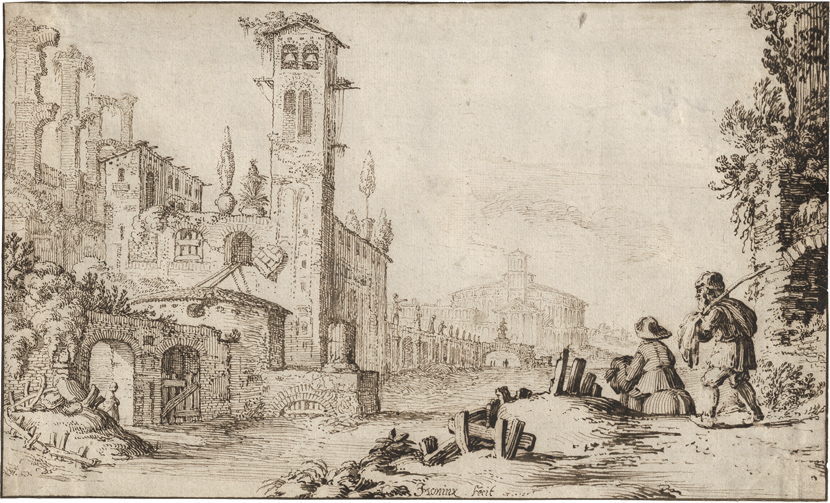Loading the page ...
Johannes Moninckx
(active in the Northern Netherlands, circa 1620–1630)
A Rider and a Wanderer in a Landscape with Ancient Buildings. Pen and brown ink, framing line in pen and brown ink. 14.5 x 24.3 cm. Signed: “JMoninx Fecit”.
This very detailed drawing, which has only recently been discovered, is an outstanding example of an Italianate Dutch landscape of the early 17th century. In the right foreground two male figures are approaching a picturesque architectural backdrop, while two miniscule staffage figures can be spotted
on the horizon. The ensemble of Roman ruins, palaces, church buildings and an amphitheatre forms a visually delightful capriccio. The artist who produced it – in all probability Johannes Moninckx who was active in the Northern Netherlands – renders the scenery from a starkly foreshortened perspective and uses subtle and varied penwork to this end. The alternating density of the hatching and the finely gradated strength of the lines in the direction of the horizon combine to create a suggestive, atmospheric perspective.
Drawings by Johannes Moninckx, of whose life very little is known, are among the rarest works of early 17th century Netherlandish draughtsmanship. The style of the few sheets by Moninckx that have been handed down reveal clear analogies with the landscape capriccios of his contemporary, Jan van de Velde the Younger (1593–1641). To date only two drawings signed by the artist are known to exist: the Landscape with Figures and Ancient Ruins, which is in the Indianapolis Museum of Art (inv. no. 1988/41), and a drawing in the manner of Lucas van Leyden showing a stone cutter operating on a man’s head (Kunsthalle, Hamburg, inv. no. 22197). The latter work is dated 1628. The different subject matter notwithstanding, the penwork in the Hamburg drawing is certainly comparable, whereas the dense and concentrated drawing style and the intricate rendering of the architecture on the sheet in Indianapolis fully match those in the present drawing, thus removing any doubt that both drawings are by the same artist. Moreover, an idiosyncratic detail such as the little garden vases with exotic plants can be found in both drawings – in the Indianapolis drawing on a board jutting out from the top of the ruined tower and in the present sheet on the roof of the church building with a campanile. The depiction of the overgrown ruins of the arcades on the left of the picture is also virtually identical. Interestingly, our drawing has been executed on fine, laid paper in contrast to the sheets in Hamburg and Indianapolis which are on parchment. This exceedingly rare drawing is in pristine condition.
Contact us for further information